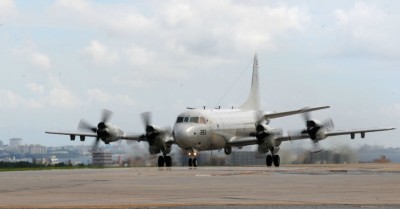Japan: New Docs Link Polluted Drinking Water Supply to Massive US Military Base

Image: A P-3 Orion lands on the airstrip at Kadena Air Force Base in Okinawa, Japan. (Photo: US Navy via flickr/cc)
Internal documents obtained by the Japan Times offer evidence that the contamination of local drinking water sources near a massive U.S. airbase in Japan is the result of years of repeated mishaps and “lax safety standards” by U.S. military forces.
The reports, obtained under the Freedom of Information Act, “expose a spate of accidents at the [Kadena Air Base in Okinawa] during the past 15 years that have involved at least 21,000 liters of fire extinguishing agents—some of them toxic.”
The reporting cites several such instances, including a three-day period in 2001 when 17,000 liters of fire extinguishing agents were released and “attributed by base officials to mechanical and electronic malfunctions.”
It also cites an incident in 2015 when “a drunk U.S. Marine activated a firefighting system. It filled a hangar with more than 1,500 liters of JET-X 2.75 percent—a foam classified by the U.S. government as hazardous. It contains chemicals known to cause cancer, and neurological and reproductive disorders.” That foam made its way to local waterways, but the base did not notify Japanese authorities.
The U.S. Pacific Air Forces issued a statement in January that—despite the detection of toxic substance in the drinking water sources— the water was safe because it is adequately treated before consumer use.
“The base continues to comply with current Japanese Environmental Governing Standards [JEGS], which are equivalent to the U.S. Safe Drinking Water Act that is enforced by the [Environmental Protection Agency]. Be assured that your drinking water is safe,”
Stars and Stripes reports the statement as saying.
The newly obtained documents, the Japan Times reports, highlight the flaws in the JEGS:
While JEGS requires the U.S. military to notify the Japanese government immediately when “a significant spill . . . threatens the local Japanese drinking water resource,” the decision on whether to categorize a spill as ‘significant’ is often left to the discretion of the U.S. military.”
Controversy surrounding the city-sized “Little America” of a base is not new, nor limited to water pollution, as Jon Letman wrote for Al Jazeera America:
the Kadena Air Base occupies over 80 percent of Kadena town and includes a 6,000-acre ammunition storage area.
The enormous base, built on land seized after World War II, contains the Air Force’s largest combat air wing, with two squadrons of F-15 fighters and an array of military aircraft that includes fighter jets, transport planes, refueling aircraft, helicopters, Ospreys, reconnaissance aircraft and anti-submarine patrol planes. According to the U.S. military, it is the “hub of airpower in the Pacific,” home to more than 9,000 U.S. service members and their families and contributes an estimated $700 million annually to the local economy.
The military lauds Kadena for promoting “regional peace and stability,” but many Okinawans see the base as a source of constant noise, pollution and tension.
The Washington Post reports this week on the ongoing protests that locals are staging to stop the planned expansion of a U.S. Marine Corps base on Okinawa, and notes that “the roar of jets” from the Kadena base “is constant and deafening.”

